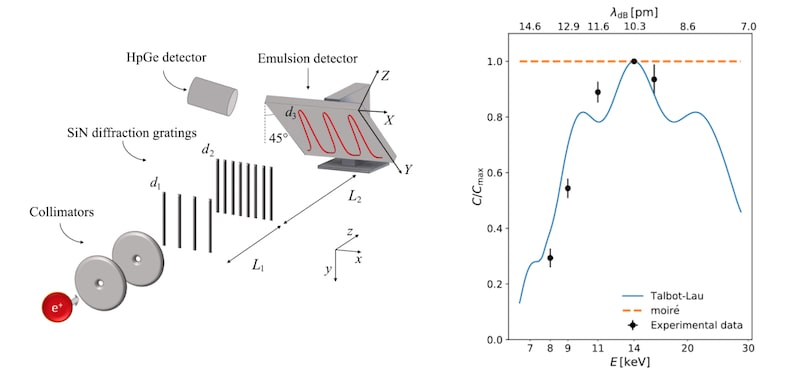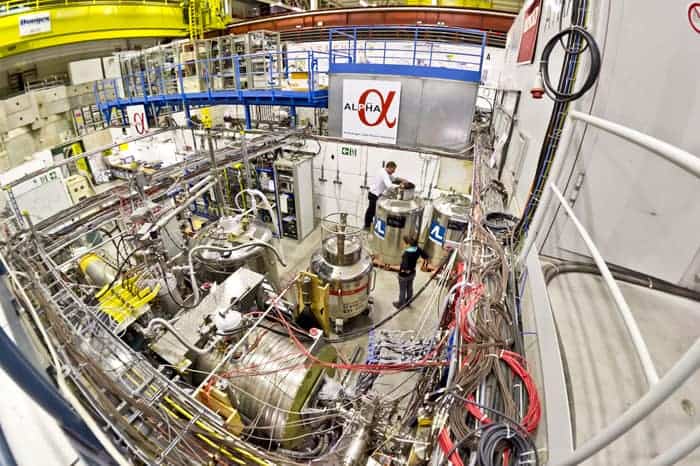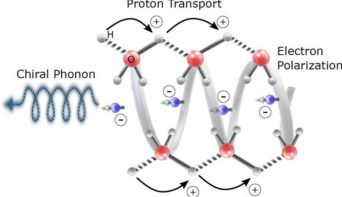
Researchers in Italy and Switzerland have performed the first ever double-slit-like experiment on antimatter using a Talbot-Lau interferometer and a positron beam.
The classic double-slit experiment confirmed that light and matter have the characteristics of both waves and particles, a duality that was first put forward by de Broglie in 1923. This superposition principle is one of the main postulates of quantum mechanics and researchers have since been able to diffract and interfere matter waves of objects of increasing complexity – from electrons to neutrons and molecules.
The QUPLAS (QUantum Interferometry and Gravitation with Positrons and LAsers) collaboration, which includes researchers from the Politecnico di Milano L-NESS in Como, the Milan unit of the Istituto Nazionale di Fisica Nucleare (INFN), the Università degli Studi di Milano and the University of Bern, has now performed the first interference experiment on positrons – the antimatter equivalent of electrons.
“The experiment was first proposed for electrons by Albert Einstein and Richard Feynman as a thought experiment and realized by Merli, Missiroli and Pozzi in 1976 and more systematically by Tonomura and colleagues in 1989,” explains QUPLAS spokesman Marco Giammarchi of the INFN. “In this original experiment, which was voted by Physics World as the most beautiful experiment, the researchers demonstrated the specifically quantum effect of single particle interference, which – according to Feynman – is the central ‘mystery’ of quantum theory.”
Talbot-Lau interferometer
In the new version, Giammarchi and colleagues made use of a modified version of a period-magnifying two-grating “Talbot-Lau” interferometer. This device contains material diffraction gratings and produces high-contrast periodic fringes.
“This interferometer operates in the intermediate field region (as opposed to the far-field in the classic Merli-Missiroli-Pozzi experiment),” explains Giammarchi. “Here, particle trajectories become waves, so that interference starts to build up from two (or more) neighbouring slits because of the wave nature of the particles. We say it is magnifying because it enhances the interference pattern from the micron-scale of the gratings to up to six microns at the detector thanks to its unequally spaced gratings. This allows us to detect the interference pattern produced.”
The device is made of gold-coated 700-nm-thick silicon nitride gratings with periodicities of (1.210 ± 0.001) μm (d1) and (1.004 ± 0.001) μm (d2) to produce a periodic interference pattern d3 of (5.90 ± 0.04) μm.
Five interference patterns
The researchers detected the fringes in the interference pattern using a sub-micron resolution device known as a nuclear emulsion detector (made in Bern), which works as a photographic film since it contains silver bromide crystals embedded in a 50-mm-thick gelatine matrix. They observed five interference patterns at energies of 8, 9, 11, 14 and 16 keV.
“We tuned our system to provide maximum visibility at 14 keV, so the pattern visibility varies with respect to energy,” says Giammarchi. “This variation is a purely quantum mechanical effect and comes from the fact that a change in energy entails a change in the de Broglie wavelength.
“This visibility dependence as a function of energy is predicted by quantum theory and cannot be explained by classical physics,” he tells Physics World. “The visibility behaviour we have observed agrees with the theory prediction.”
In their experiments, the researchers used positrons from the variable energy positron beam facility at L-NESS (the Laboratory for Nanostructure Epitaxy and Spintronics on Silicon) in Como. They implanted positrons (e+) from the beta decay of a 22Na radioactive source on a monocrystalline tungsten film, where they were emitted with a kinetic energy of about 3 eV. They then accelerated slow positrons up to 16 keV using an electrostatic system to create a monochromatic and continuous positron beam that has an energy spread of less than 0.1%. The positrons are emitted at a rate of around 5 x 103 e+/s and the beam can be tuned to a spot with a focal size that is roughly several millimetres at full width at half maximum (FWHM).

Interferometry tips the scales on antimatter
Testing the weak equivalence principle and the CPT theorem
The new work heralds the beginning of the field of antimatter quantum interferometry and the main application for the technique will be to explore antimatter neutral systems such as antihydrogen, which is the antimatter equivalent of hydrogen and contains a positron and an antiproton. These studies could allow researchers to measure the gravitational properties of antimatter (does it fall up or down, for example?). Such measurements are of fundamental importance for testing the weak equivalence principle (which could have far-reaching consequences for cosmology) and the CPT theorem (which says that the laws of physics remain the same if the charge, parity and time-reversal properties of a particle are inverted together).
“Violation of these principles could show that the Standard Model of particle physics is incomplete or hold the key to our understanding of the mystery of matter-antimatter asymmetry in the universe,” explains Giammarchi.
The Como-Milan-Bern team will now be looking to build up the positronium beam at L-NESS so that it can start making such measurements. “A side application of what we have achieved could be to study decoherence with antimatter systems for the first time.”
The research is detailed in Science Advances.



